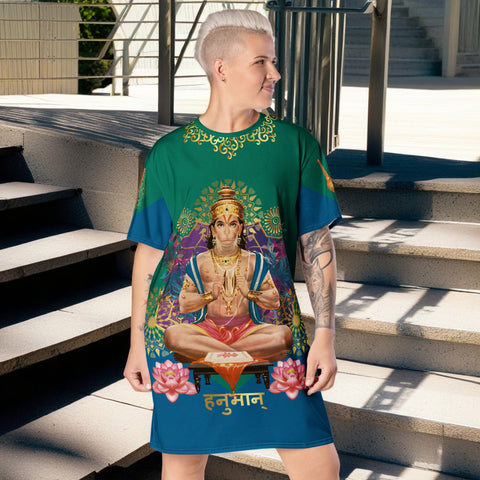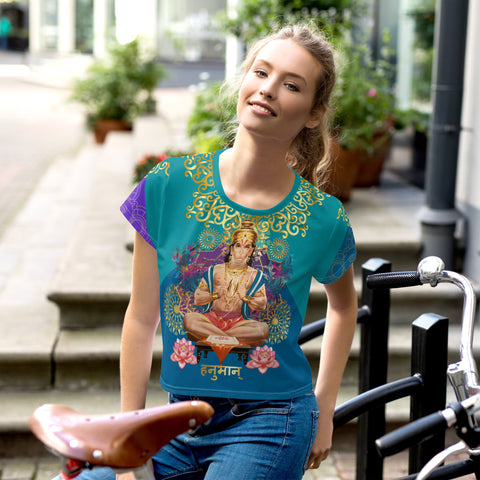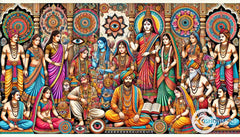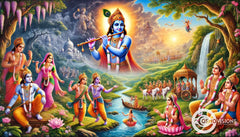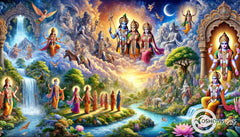Hanuman: The Hindu Monkey God of Ramayana and Medicinal Herbs
Posted by Massimiliano Geraci
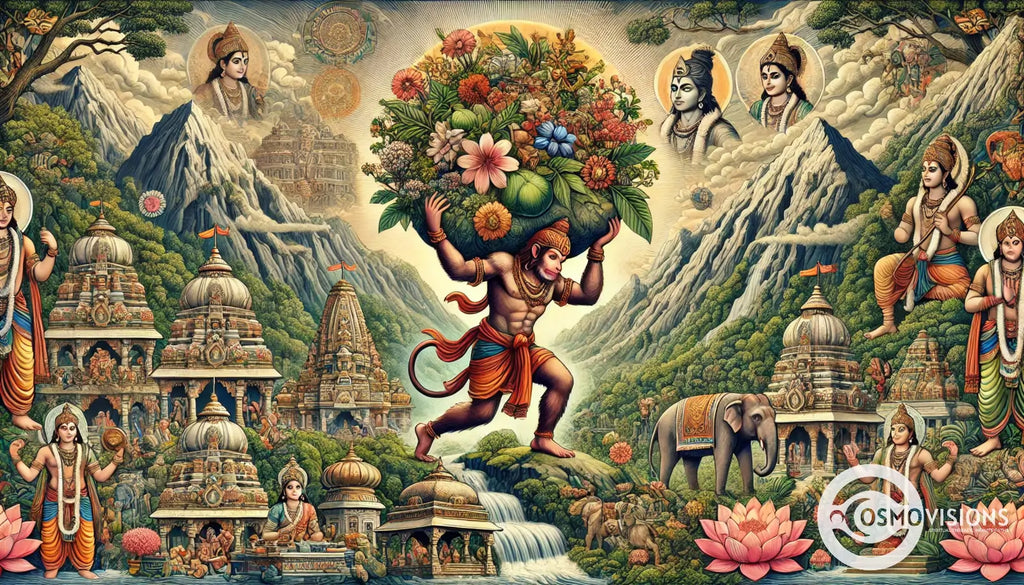
Many people around the world are fascinated by mythology and the powerful deities within these ancient stories. If you're searching for a compelling tale that combines strength, loyalty, and the wisdom of medicinal herbs, consider Hanuman, the Hindu monkey deity.
Revered in Hindu mythology for his unwavering devotion to Lord Rama and his crucial role in the Valmiki's Ramayana, Hanuman's story is a rich tapestry of bravery and service.
One intriguing aspect of Hanuman’s lore is his miraculous feat of lifting an entire mountaintop to retrieve medicinal herbs essential for healing Lakshmana, Rama’s brother. This act not only showcases his immense power but also symbolizes deep knowledge of herbal medicine.
Our article will explore how this divine figure bridges spirituality and ancient medical wisdom while being celebrated across various cultures in India through temples, rituals, and art.
Discover why Hanuman remains one of Hinduism’s most beloved figures.
Join us on this spiritual journey.
Who is Hanuman in Hindu Mythology?
Hanuman stands as a pivotal deity in Hindu mythology, revered as the son of Vayu, the son of the wind, god, and Anjana. His tale is intricately woven into the epic Ramayana, where he emerges as a devout follower of Rama, an incarnation of Lord Vishnu.
Known for his unwavering devotion and immense strength, Hanuman played a critical role in Rama's quest to rescue Sita from Ravana, the demon king of Lanka. His feats include leaping across oceans and carrying entire mountains bearing medicinal herbs to heal Lakshmana, showcasing his supernatural powers granted by various gods including Shiva and Indra.
Devotion embodies strength; Hanuman is its epitome.
Attributes such as agility, bravery, purity of mind, and selfless service define Hanuman's character making him not just a beloved figure in the narrative but also a symbol of moral integrity across generations.
He seamlessly blends elements of shakti (power), bhakti (devotion), and dharma (duty), embodying qualities that transcend mere physical strength to encompass spiritual wisdom and humility.

Hanuman's Origins: Birth and Early Life
Born to Anjana, a celestial nymph (apsara), and Kesari, a mighty vanara king, through divine intervention by the wind god Vayu, Hanuman's birth is marked with exceptional tales of divinity.
His mother Anjana was cursed to live on earth as a monkey but was relieved of this curse after giving birth to Hanuman—the incarnation of Shiva. The unique circumstances of his origin forecasted his future as no ordinary being but one destined for greatness.
The young Hanuman exhibited extraordinary powers from an early age, reflecting his divine parentage and the boons granted by various gods. As a child, mistaking the sun for a ripe fruit, he leaped into the sky in an attempt to catch it.
This act alarmed Indra, king of gods, who struck hanuman defeated put him down only for Vayu to revive him and assure hanuman received his protection against all harms. Thus began the journey of Hanuman towards becoming a central figure in Hindu dharma and an ardent devotee dedicated to serving Rama and Sita throughout episodes from Ramayana.
The Role of Hanuman in the Ramayana
Hanuman plays a pivotal role in the Ramayana, serving as an ardent devotee of Rama and a central figure in the epic's narrative. His journey begins when he meets exiled prince Rama and becomes an unwavering supporter, leading to numerous adventures across India.
With his incredible strength, intelligence, and devotion, Hanuman helps Rama in the quest to rescue Sita from the demon king Ravana. This act elevates him as a hero and cements his position as a symbol of bhakti (devotion) within Hindu mythology.
In one of the most celebrated episodes known for bearing the mountaintop with medicinal herbs, Hanuman showcases both his might and dedication. When Lakshmana is gravely injured in battle, it falls upon Hanuman to procure life-saving herbs from the Himalayas.
Demonstrating his unmatched powers and commitment to Rama's cause, he lifts an entire mountain segment carrying it back to ensure Lakshmana’s healing. This legendary feat highlights Hanuman's role not just as a warrior but also as a healer within the Ramayana narrative—an embodiment of service and sacrifice for the greater good.
Attributes and Powers of Hanuman
Gifted with immense strength, Hanuman stands as a central figure in Hindu mythology, demonstrating abilities far beyond the ordinary. His divine powers include changing his form at will, allowing him to shrink to the size of an ant or expand to the size of a mountain.
This flexibility illustrates his mastery over physical dimensions and highlights his role as a formidable warrior in battles recounted in epics like the Ramayana and Mahabharata. Alongside his might, Hanuman's devotion to Rama and Lakshmana showcases his unwavering Bhakti yoga practice, making him an exemplary figure in the Hindu pantheon.
Hanuman’s prowess extends beyond brute strength; he possesses profound wisdom and knowledge of Sanskrit and embodies virtues such as humility and courage. Notably, he played a critical role by leaping across oceans carrying a mountain bearing medicinal herbs to heal Lakshmana—an act that symbolizes his unparalleled dedication and service.
His ability to remove obstacles as Vayu's son further solidifies Hanuman’s position as an avatar who transcends mere physical capabilities, weaving together strands of devotion, loyalty, and fearlessness into Hindu culture's rich tapestry.
What Are the Key Stories Featuring Hanuman?
Hanuman's adventures unfold in several key narratives that have captivated minds for centuries. In one memorable tale, Hanuman bears the entire mountaintop with medicinal herbs to heal Lakshmana, showcasing his unparalleled strength and devotion.
This story highlights Hanuman's deep knowledge of medicinal plants, a testament to his connection with the natural world and his role as a protector. Another pivotal moment comes when Hanuman meets Rama for the first time, marking the beginning of an unwavering service and friendship between them.
His journey to Lanka serves as a testament to his bravery, where he leaps across oceans and faces numerous challenges to deliver Rama’s message to Sita.
Hanuman's encounters in these stories reflect themes of loyalty, courage, and service that resonate deeply within Hindu tradition. Each narrative showcases different facets of his character — from warrior to devoted servant — illustrating why he remains one of the most revered figures in Hindu mythology.
Through every deed and action, Hanuman embodies the virtues of courage, loyalty, and selflessness.
Hanuman Bearing the Mountaintop with Medicinal Herbs
In a pivotal moment, Hanuman bears the weight of an entire mountaintop to transport medicinal herbs to save the life of Lakshmana, demonstrating his incredible strength and devotion.
This act occurs during an intense battle in the ancient epic, Ramayana, where Lakshmana lies critically injured and only specific herbs from the distant Dronagiri mountain can heal him.
Unable to identify these life-saving herbs, Hanuman uplifts all the air and whole mountain with unwavering resolve and flies it across India to ensure Lakshmana’s recovery. This extraordinary deed highlights his might and his role as a devoted follower of Rama, embodying selfless service and unparalleled dedication.
The incident captures Hanuman’s essence as both a powerful warrior and a benevolent guardian. His actions are celebrated in numerous religious texts including the Ramcharita Manas by Tulsidas, underscoring his significance in Hindu worship and spirituality.
Through this narrative, Hanuman's portrayal transcends that of mere physical prowess; he emerges as a symbol of Bhakti (devotion), showcasing how faith can lead to miraculous endeavors.
Moving forward into other adventures in Lanka further explores Hanuman's multifaceted character – from being an astute messenger to becoming an indomitable force against adversaries.
Hanuman Meets Rama for the First Time
Hanuman's first encounter with Rama marks a pivotal moment in the epic Ramayana, setting the stage for an unbreakable bond of devotion and service. Disguised as a humble monk, Hanuman approaches Rama and his brother Lakshmana during their search for Sita, who had been abducted by Ravana.
The meeting takes place under auspices that suggest destiny at play; it is here in Kishkindha where the foundations of trust and respect between deity and devotee are laid. Rama, the incarnation of Vishnu, initially unaware of Hanuman's divine nature, quickly perceives his unwavering loyalty and immense strength.
This significant event symbolizes the merging paths of divinity and devoutness, propelling Hanuman to become a central figure in assisting Rama while underscoring his role as an emblematic hero within Hindu mythology.
Moving from this pivotal narrative juncture leads naturally into exploring "Hanuman's Adventures in Lanka," where his dedication human devotion to serving Rama shines brightly against all odds.
Hanuman's Adventures in Lanka
After meeting Rama, Hanuman began a pivotal journey to Lanka. His mission was crucial: he sought to find Sita, wife of Rama, who had been abducted by the demon king of Lanka, Ravana.
With unmatched devotion and bravery, Hanuman leaped across the ocean in a single bound to reach the island kingdom. This act underscores his incredible powers granted by the gods and his unwavering dedication to service.
In Lanka, Hanuman demonstrated wit and strength. He moved through enemy territory, discovered Sita's location in Ashoka Vatika, and delivered Rama’s message to her. To signal his presence and challenge Ravana’s might, he set fire to Lanka with his tail after it was set ablaze by Ravana's minions.
Hanuman returned triumphantly to Rama with vital information about Sita’s situation. This adventure highlights Hanuman’s role as a messenger and as a formidable warrior who played a critical part in Sri Ramcharitmanas and further solidified the bond between him and Lord Rama.

How is Hanuman Worshiped in Hinduism?
Devotees show their respect and devotion to Hanuman in numerous ways, reflecting the depth of his significance in Hinduism. Many visit temples dedicated to Hanuman, where they engage in prayers and rituals aimed at seeking his blessings for strength, courage, and protection.
The Hanuman Chalisa, a devotional hymn composed by Tulsidas in the 16th century, is recited with fervor by followers across India and beyond. This forty-verse hymn praises Hanuman's attributes, recounting his unyielded devotion to Rama and invoking his aid in dispelling fears.
Throughout the year, several festivals and rituals celebrate Hanuman’s valor and benevolence—Hanuman Jayanti being the most prominent among them. On this day marking Hanuman’s birthday, devotees flock to temples from early dawn till late at night offering prayers, chanting mantras like those found within Shaivism and Vaishnavism traditions which highlight unity between divine figures through bhakti (devotion).
They also honor him by applying sindoor (vermilion) on idols symbolizing life force energy or Shakti believed inherent within everyone as per Shakta tradition of Hindu philosophy.
Serving Lord Rama is my only purpose.
Temples Dedicated to Hanuman
Hanuman, the revered Hindu deity known for his unwavering devotion to Lord Rama, is worshiped in countless temples across India and beyond. These sacred spaces are not just places of worship but also centers of cultural and spiritual significance that attract devotees from all walks of life.
1. Hanuman Dhara Temple, located in Chitrakoot, stands out for its unique natural spring thought to have been created by Rama to cool down Hanuman after he set Lanka on fire. This temple offers a picturesque view of the town and has a series of steps leading up to the idol, making it a significant site for pilgrims.
2. Sankat Mochan Hanuman Temple in Varanasi is one of the most famous Hanuman temples, attracting devotees with its deep historical roots tied to the poet-saint Tulsidas. This temple plays a crucial role during Hanuman Jayanti celebrations, drawing thousands to seek blessings and participate in religious activities.
3. The Anjaneya Swamy Temple in Anegundi, Karnataka, holds historical importance as it is thought to be the birthplace of Hanuman. According to legends, this is where Añjanā carried out penance to give birth to Hanuman, making this site immensely significant for devotees seeking divine support for parenthood.
4. Mahavir Mandir in Patna is renowned for being one of the holiest temples dedicated to Lord Hanuman. It ranks second in terms of revenue collection among the temples in North India. Devotees flock here to offer their prayers and seek solace from their sufferings.
5. Prasanth Varma announced Primeshow Entertainment's production featuring Teja Sajja and Amritha Aiyer in key roles, showcasing cultural narratives surrounding Hanuman's legends woven into contemporary storytelling.
6. The Shree Maruti Temple located in Panjim, Goa showcases unique architectural beauty reminiscent of Portuguese influences mingled with traditional Indian temple architecture. Its nightly illumination adds an ethereal glow that draws both locals and tourists alike.
7. The Jakhoo Temple situated at Shimla's highest peak offers a panoramic view of the snow-capped Himalayas along with housing a giant 108 feet tall statue of Hanuman. This monumental idol can be seen from various parts of Shimla city and symbolizes strength, perseverance, and devotion.
8. In Mumbai’s suburb Borivali lies the Swaminarayan Gadi Sansthan’s Maninagar Shree Swaminarayan Gadi Sansthan - Shree Ghanshyam Maharaj Mandir which houses mesmerizing depictions from scenes of Ramayana including Hanuman’s adventures reflecting his unyielding dedication to Rama.
9. Balaji Mandir at Mehendipur in Rajasthan stands apart due to its belief in possessing powers that rid individuals from evil spirits or black magic afflictions through specific rituals conducted within its premises; showing another aspect where faith in Hanuman transcends into healing practices.
10. Lastly, Sri Viswaroopa Panchamukha Anjaneya Swami Ashram located near Kumbakonam represents one-of-a-kind representation where Lord Hanuman is envisioned with five faces – representing Varaha facing Northwest signifying win over internal foes embodying valor resonating strongly with teachings found within Puranas highlighting victory through righteous path adhering strictly to principles laid down by divine entities emphasizing moral fortitude above everything else thus serving as guiding.

The Hanuman Chalisa: A Devotional Hymn
The Hanuman Chalisa stands as an essential devotional hymn in the spiritual practices surrounding Hanuman, deeply revered across regions speaking Telugu, Tamil, Kannada, and beyond into South India.
Composed by Tulsidas in the Awadhi language during the 16th century, this hymn encapsulates Hanuman’s immeasurable strength, wisdom, and his unwavering devotion to Rama. Spanning forty verses, each segment invites followers into a reflective journey of Hanuman's exploits and teachings.
Devotees often recite it to summon courage and find solace in times of distress.
This sacred text bridges the devotee's earthly existence with divine aspirations and fortifies their connection with one of Hinduism's most cherished deities. Through its rhythmic recitation, individuals engage deeply with the Bhakti movement’s core ideals—a personal connection with divinity rooted in love and devotion.
Beyond its religious significance, scholars like Devdutt Pattanaik have explored its cultural resonance within Hindu studies further connecting believers to their ancestral faiths while fostering a sense of unity among diverse linguistic communities throughout China to metropolitan centers where Indic traditions thrive.
Transitioning from the devout melodies of The Hanuman Chal preached through ages paints a vivid picture for Festivals and Rituals Celebrating Hanuman
Festivals and Rituals Celebrating Hanuman
Honoring Hanuman goes beyond merely acknowledging his tales; it integrates his essence into the lives of millions through vibrant festivals and rituals. These celebrations carve a sacred space in the hearts of devotees, uniting them in communal devotion and admiration for the Hindu god.
1. Hanuman Jayanti marks the birth of Hanuman, celebrated widely across India during the month of Chaitra (March-April). Devotees flock to temples dedicated to Hanuman, engaging in prayers, singing devotional hymns like the Hanuman Chalisa, and offering flowers and sweets. This festival highlights Hanuman's role as a symbol of strength and loyalty in Hindu mythology.
2. On Tuesdays, considered auspicious for worshiping Hanuman, devotees visit temples to offer sindoor (vermilion) and oil to statutes of the monkey god. This tradition stems from the belief that sindoor applied to his image invokes Hanuman’s blessings for health and prosperity.
3. The practice of reading the Ramayana during religious festivals underscores Hanuman's significance in aiding Rama's victory over Ravana. Communities organize recitations, where excerpts detailing Hanuman’s heroics are emphasized, fostering a sense of bravery and service among listeners.
4. In Tamil Nadu, the festival of Ayyappan Puja sees significant homage paid to Hanuman as a guardian deity who aids Lord Ayyappan. Devotees carry offerings on their heads and walk barefoot to temples, mirroring Hanuman's unwavering dedication to service.
5. The Anjaneya Utsavam in Karnataka features a unique procession where idols of Hanuman are adorned with flowers and taken through streets on chariots or palanquins. Music, dance performances, and distribution of Prasad (sacred food) make this event a joyous community gathering.
6. During Diwali, while primarily celebrating Rama's return after defeating Ravana, many also pay respects to Hanuman for his crucial role in this victory. Special pujas are conducted where offerings like sweets made from jaggery and ghee are made to honor his contribution.
7. The ritualistic application of oil on Saturdays at specific shrines is believed to alleviate problems caused by Saturn (Shani). This practice acknowledges Hanuman’s power over celestial influences affecting one's life path.
Exploring these festivals and rituals provides insight into how deeply embedded Hanuan is within Hindu tradition – not just as a deity but as an emblematic figure representing unwavering fidelity and strength against adversity.
Next: What Are the Different Forms and Representations of Hanuman?

What Are the Different Forms and Representations of Hanuman?
In the intricate tapestry of Hindu deities, Hanuman's visage shifts remarkably, embodying strength and devotion across diverse cultures. Iconography reveals him predominantly as the Monkey God, a form that resonates with his mythological role as a valiant protagonist in scenes from the Ramayana.
Artists depict Hanuman carrying mountains for medicinal herbs to save lives, showcasing his unwavering dedication. This representation also underscores his godly attribute - the ability to perform extraordinary feats when devoted to a cause.
Hanuman's identity transcends regional boundaries, leading to variations like Anjaneya in Telugu language circles and other forms influenced by local traditions. Modern depictions extend into superhero films where actors like Raj Deepak Shetty and Vinay Rai bring this venerable Monkey Hero to life on screen.
These adaptations highlight Hanuman’s enduring appeal, bridging ancient lore with contemporary narratives. Through these lenses, Hanuman evolves from just another figure in Hindu mythology into an icon of resilience and loyalty.
Though Hanuman is often seen wielding thunderbolt-like power, it is his service to Rama and Sita that truly defines him.
Iconography: Hanuman as the Monkey God
Hanuman is depicted as the Monkey God, a form that resonates deeply within Hindu iconography and spirituality. His image, often seen with a red face symbolizing courage and devotion, captures the essence of his unwavering service to Rama, an incarnation of the god Vishnu.
Hanuman's portrayal in art and sculptures frequently shows him carrying a mountain to fetch medicinal herbs for Lakshmana, showcasing his strength and selflessness. This iconic representation tells stories from versions of the Ramayana by sage Valmiki and highlights Hanuman’s close connection to divine powers.
Artists have been inspired by tales where Hanuman leaps across oceans or carries entire mountains; such imagery reinforces his might and fearless nature. Temples dedicated to Hanuman display statues that feature him in dynamic poses—either flying through the air or assuming a powerful stance ready for battle.
These images serve as visual reminders of his abilities granted by other gods like Indra, who bestowed upon him immense physical power. Whether depicted standing tall beside Rama or shown kneeling in devotion before him, each representation of Hanuman invites devotees and admirers into a deeper understanding of this heroic deity’s role within Hindu mythology and spirituality.
Regional Variations: Anjaneya, and Other Forms
Shifting focus from the universally recognized iconography of Hanuman as a monkey god, we explore the fascinating regional variations like Anjaneya and other forms that illuminate the multifaceted nature of his veneration across different cultures.
In Tamil tradition, he is Anjaneya, son of Anjana, emphasizing his divine birth and celestial lineage. This name highlights his connection to Vayu, the wind god, and Shiva Purana stories where Shiva grants Anjaneya unmatched powers.
Exploring further south into Karnataka and Andhra Pradesh reveals even more layers to Hanuman's character through local folklore and temple traditions. For instance, Madhvacharya identifies Hanuman with Vayu himself in a dual role as both servant and incarnation of Vishnu (Rama), which enriches our understanding of Hanuman’s devotion to the god Rama.
These regional narratives diversify the portrayal of Hanuman while underlining a universal theme: regardless of form or name—Anjaneya in Tamil culture or Maruti in parts of Maharashtra—his essence as a devout follower, protector from evils, and symbol of strength remains constant.
Through chants like the "Hanuman Chalisa" adapted into various languages including Bengali version by Samarth Ramdas or performances in cultural contexts such as those by Indian artists Vennela Kishore and Anudeep Dev illustrate how Hanuman transcends geographical boundaries while adapting uniquely within them.
Modern Depictions of Hanuman in Art and Culture
Artists and storytellers of the modern era paint Hanuman in a spectrum of media, illustrating his legacy beyond the ancient texts into digital art, animation, and contemporary spiritual iconography.
The evolution from traditional to current depictions highlights him as a figure of devout strength and as an adaptable cultural icon resonating with diverse audiences worldwide. His image graces murals and posters in metropolitan spaces, bringing sacred narratives to everyday life.
Films and graphic novels weave tales where Hanuman's powers illuminate screens and pages, blending mythology with modern challenges. Here, Hanuman becomes a bridge between generations—the timeless hero whose adventures in versions of the Ramayana and other epics are recounted using today's languages—be it through Tamil animations or Bengali literature adaptations.
In these forms, Hanuman stands erect as both protector and guide, his story continually adapting yet fundamentally unchanged at its core.
How Does Hanuman Connect with Other Gods in the Hindu Pantheon?
Hanuman's relationship with Rama, a central figure in the Ramayana, exemplifies devotion and loyalty unparalleled in Hindu mythology. As an ardent follower of Rama, Hanuman embodies service and dedication, fulfilling tasks that are deemed impossible by others.
This connection portrays the ideal devotee in Hindu spirituality, where unwavering faith enables divine achievements. Hanuman also carries a significant link to Vayu, the wind god, marking him as divine offspring and aligning his powers with those governing life's breath and movement across various realms.
Beyond these direct connections, Hanuman intersects with other deities through interactions that underscore his role within epic narratives like the Mahabharata. His aid extends to various gods and heroes when facing dire challenges, further embedding him into the fabric of divine tales.
These relationships highlight Hanuman's indispensable contributions and illustrate the interconnectedness among gods within Hindu epics—where every deity plays a role in maintaining cosmic balance.
Moving forward in our exploration allows us to explore The Legacy of Hanuman in Hindu Epics – Ramayana and Mahabharata.
Hanuman and Rama: The Devoted Follower
Hanuman met Rama during a pivotal moment in the epic tale of the Ramayana, marking the beginning of an unbreakable bond between a deity and his devoted follower. This encounter set the stage for Hanuman's unwavering loyalty to Rama, embodying human devotion's purest form.
Hanuman's commitment to finding Sita led him across vast distances, showcasing his boundless dedication and supernatural abilities granted by gods like Indra and Vayu. His journey exemplifies the lengths to which he would go to fulfill Rama’s wishes, highlighting Hanuman’s role as not just a follower but as an integral force in the battle against evil.
Taking on perilous missions into Lanka, Hanuman demonstrated courage and cunningness that were instrumental in Sita's rescue. His fiery tail became a symbol of resilience when set ablaze by Ravana's forces; instead of succumbing to despair, Hanuman turned adversity into advantage by setting Lanka aflame.
Through these acts, Hanuman reaffirmed his allegiance to Rama and displayed unparalleled bravery and resourcefulness that resonate deeply with those who revere him as a model of devout service and protection.
The Parentage: Hanuman and Vayu, the Wind God
Moving from Hanuman's deep devotion to Rama, the sun god, we explore the origins of this unwavering loyalty by examining his celestial lineage. Central to Hanuman’s divine birth story is Vayu, the wind god, who played a pivotal role hanuman's birth and in shaping his destiny.
The unique parentage granted Hanuman remarkable abilities and establishes him as an extraordinary figure within Hindu mythology.
Hanuman's connection with Vayu traces back to an incident that left him blessed by several deities, including Brahma and Indra. This divine intervention was crucial after a youthful Hanuman mistook the sun for a ripe fruit and attempted to reach it, prompting Indra to strike him down.
Vayu, in grief over his son's plight, withdrew air from earth till other gods intervened, bestowing upon Hanuman gifts that would mark his path as one of valor and strength in servitude to good.
These episodes highlight how celestial forces intertwined to bring forth a being whose exploits are celebrated across versions of the Ramayana and beyond, firmly rooting Hanuman within the pantheon as not just a devotee of Rama but as a venerated deity with profound connections across different realms.
The Legacy of Hanuman in Hindu Epics – Ramayana and Mahabharata
Hanuman's legacy in the Hindu epics of Ramayana and Mahabharata is profound, bridging the gods with humanity through his unwavering devotion and strength. In the Ramayana, Hanuman serves Lord Rama with unmatched fidelity, his journey to Lanka to find Sita becoming a testament to his courage and dedication.
His ability to leap vast distances and carry a mountain for medicinal herbs showcases his physical prowess and his deep knowledge of Ayurveda, making him revered in both spirituality and medicine.
In the lesser-known narratives within the Mahabharata, Hanuman appears as a symbol of wisdom and valor. He meets Bhima, one of the Pandava brothers, displaying humility by teaching him about strength beyond physicality.
This interaction underlines Hanuman’s role as Vayu's son—a divine manifestation embodying wind's powerful yet gentle nature. Throughout these epic tales, Hanuman embodies virtues that transcend time—devotion (Bhakti), service (Seva), humility (Vinamrata), showing how deeply interwoven he is in India’s spiritual fabric alongside deities like Rama and figures from ancient lore such as Jambavan and Agni.





